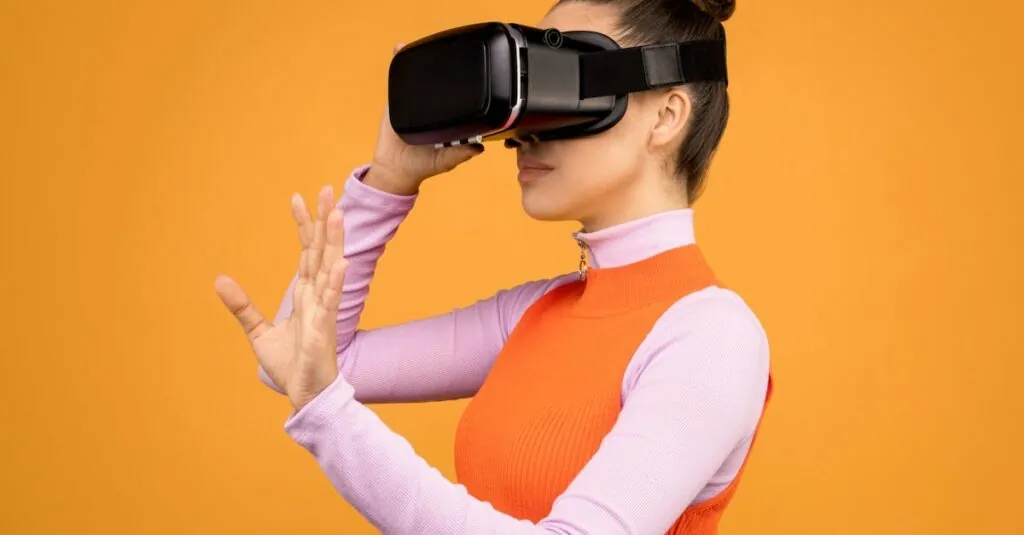Table of Contents
ToggleIn a world where reality sometimes feels a bit too mundane, augmented reality (AR) and virtual reality (VR) solution companies are here to sprinkle a little magic dust on everyday life. Imagine stepping into a new dimension where your living room transforms into a bustling city or a serene forest. It’s not just sci-fi anymore; it’s happening right now, and it’s changing the way people interact with the world.
Overview of Augmented Reality and Virtual Reality
Augmented reality (AR) and virtual reality (VR) represent significant advancements in technology. AR overlays digital information onto the physical world, providing interactive experiences. For instance, applications can change everyday environments by adding layers of information, enhancing how users perceive reality.
VR, on the other hand, immerses users in entirely computer-generated environments. This technology transports individuals to different places, allowing them to interact with a wholly virtual setting. Businesses utilize VR for training simulations, which can improve skills and reduce risks.
Both AR and VR have found applications across various industries. In gaming, they create engaging experiences that captivate players. Retailers employ AR to allow customers to visualize products in real time, fostering better purchasing decisions. Educational institutions use VR to offer students experiential learning opportunities, bridging gaps between theoretical knowledge and real-world application.
Key players in the AR and VR market focus on innovation and adaptability. Companies develop solutions tailored specifically to enhance user experiences. These organizations invest in research and development to stay competitive and meet evolving consumer demands.
Augmented reality and virtual reality technologies are not just trends; they shape the future. As these solutions become more accessible, from hardware to software, their impact on daily life continues to grow. Stakeholders recognize the potential, driving investments and collaborations to explore new possibilities.
Key Players in the Industry
The AR and VR industry features a mix of established companies and innovative startups pushing the boundaries of technology. These key players contribute significantly to defining the landscape of immersive solutions.
Major Companies
Microsoft shapes the industry with its HoloLens, targeting enterprise applications through augmented experiences. Facebook, now Meta, emphasizes social interaction within immersive environments, particularly in virtual reality. Google invests in both AR and VR, seeking to enhance user experiences with products like Google Glass and the Daydream platform. Sony strengthens its position through PlayStation VR, catering to gamers with rich virtual experiences. Unity Technologies provides robust development tools, making it easier for creators to build AR and VR applications across multiple industries.
Emerging Startups
Startups such as Niantic focus on augmented reality, creating engaging experiences like Pokémon GO that encourage outdoor exploration. Magic Leap specializes in spatial computing, bringing immersive experiences to various sectors, including healthcare and education. Varjo targets high-fidelity VR with advanced headsets, aiming for professional applications in design and training. Infinadeck offers untethered locomotion solutions, enhancing user immersion in VR environments. Finally, Rec Room promotes social VR experiences, allowing users to create and interact in virtual spaces, appealing to younger demographics.
Solutions Offered by Companies
Companies in the AR and VR sectors deliver a range of innovative solutions. These solutions include advancements in both software and hardware, driving immersive experiences.
Software Development
Software development plays a crucial role in enhancing user interactions. Companies create AR applications that overlay digital content onto real-world environments, enriching experiences in retail and education. VR software packages simulate realistic environments, enabling users to explore virtual landscapes. Game development also benefits from these advancements, capturing user engagement through interactive gameplay. Custom solutions cater to specific industry needs, such as training simulations in healthcare or virtual classrooms in education. Collaboration with consumers ensures these offerings align with evolving demands.
Hardware Innovations
Hardware innovations are vital for delivering high-quality experiences in AR and VR. Manufacturers design lightweight headsets, making extended use comfortable for users. Advanced sensors track movements accurately, ensuring immersive navigation within virtual spaces. High-resolution displays enhance visual fidelity, making environments more lifelike. Portable AR devices enable users to interact seamlessly with digital elements in various settings. Innovations in haptic feedback technology elevate engagement levels, allowing users to feel sensations within virtual environments. Companies continually invest in developing cutting-edge hardware to meet industry standards and user expectations.
Market Trends and Insights
Growth in augmented reality (AR) and virtual reality (VR) markets shows no signs of slowing. According to a report by Fortune Business Insights, the global AR market size may reach 198 billion USD by 2025, growing at a compound annual growth rate of 43.8%. VR’s market is expected to follow suit, potentially reaching 97 billion USD by 2027 with a CAGR of 33.47%. These statistics exemplify accelerating demand across various sectors.
Gaming remains a driving force behind AR and VR advancements. As immersive experiences gain traction, companies invest in richer content and innovative gameplay. Retail also capitalizes on these technologies by enhancing customer engagement through virtual try-ons and AR experiences. Brands such as IKEA launch apps that let users visualize furniture in their spaces.
Education utilizes AR and VR tools to revolutionize learning. Statistics reveal that immersive learning increases knowledge retention rates by up to 75%. Companies are partnering with educational institutions to create tailored solutions, promoting interactive teaching methods. Industrial training benefits as well, with VR simulating real-life conditions for safer, more efficient skills development.
Companies prioritize accessibility alongside innovation. Enhanced hardware developments reduce costs while improving user comfort and experiences. The introduction of 5G is enabling seamless streaming of high-quality content, further attracting user adoption. Emerging startups focus on niche markets, creating customized applications that address specific industry needs.
Sustainability also plays an essential role in current trends. Increasingly, organizations seek eco-friendly solutions in product development. By using technology to reduce waste and enhance operational efficiency, companies build a more sustainable future. As these trends evolve, companies in the AR and VR sectors continue to adapt, ensuring they remain competitive in a rapidly changing landscape.
Challenges Faced by Solution Companies
Competition poses a significant challenge for augmented reality and virtual reality solution companies. With numerous established firms and innovative startups in the market, standing out requires consistent innovation and exceptional quality. Many businesses struggle to maintain a competitive edge as technological advancements accelerate and consumer expectations evolve.
Integration issues frequently arise when adopting AR and VR technologies. Companies often find it challenging to incorporate these solutions into existing systems and workflows. Lack of standardization across devices and platforms complicates the compatibility of software and hardware. Developers must design solutions that function seamlessly across various ecosystems to enhance user experiences.
Cost remains a critical barrier for many organizations exploring AR and VR adoption. Development expenses for creating high-quality applications and purchasing advanced hardware can be substantial. As companies prioritize affordability, they face the task of balancing performance with cost while ensuring access to immersive technologies for a broader audience.
User adoption presents another hurdle that solution companies must navigate. While AR and VR offer engaging experiences, potential users often demonstrate hesitancy in embracing new technologies. Companies must invest in education and marketing strategies to communicate the benefits of these solutions effectively. Providing hands-on demonstrations can help alleviate fears and increase interest.
Data privacy and security issues also create challenges within the AR and VR sectors. Companies may struggle with safeguarding users’ personal information while delivering tailored experiences. Ensuring compliance with regulations such as GDPR becomes a priority as solution companies seek to establish trust and transparency in their dealings.
Lastly, maintaining technological updates is vital for ensuring ongoing innovation. Rapidly advancing technology necessitates constant adaptation, which can strain resources. Companies that invest in research and development will likely keep pace with trends and maintain their market position.
The landscape of augmented reality and virtual reality continues to evolve, offering unprecedented opportunities for innovation across various sectors. Companies in this space are not just enhancing user experiences but are also addressing significant challenges related to integration, cost, and user adoption. As they invest in cutting-edge technologies and prioritize accessibility, the potential for AR and VR to transform industries remains immense. With the support of advancements like 5G and a focus on sustainability, these technologies are set to redefine how individuals interact with their environments. The future looks promising as key players and emerging startups work together to push the boundaries of what’s possible in immersive experiences.







